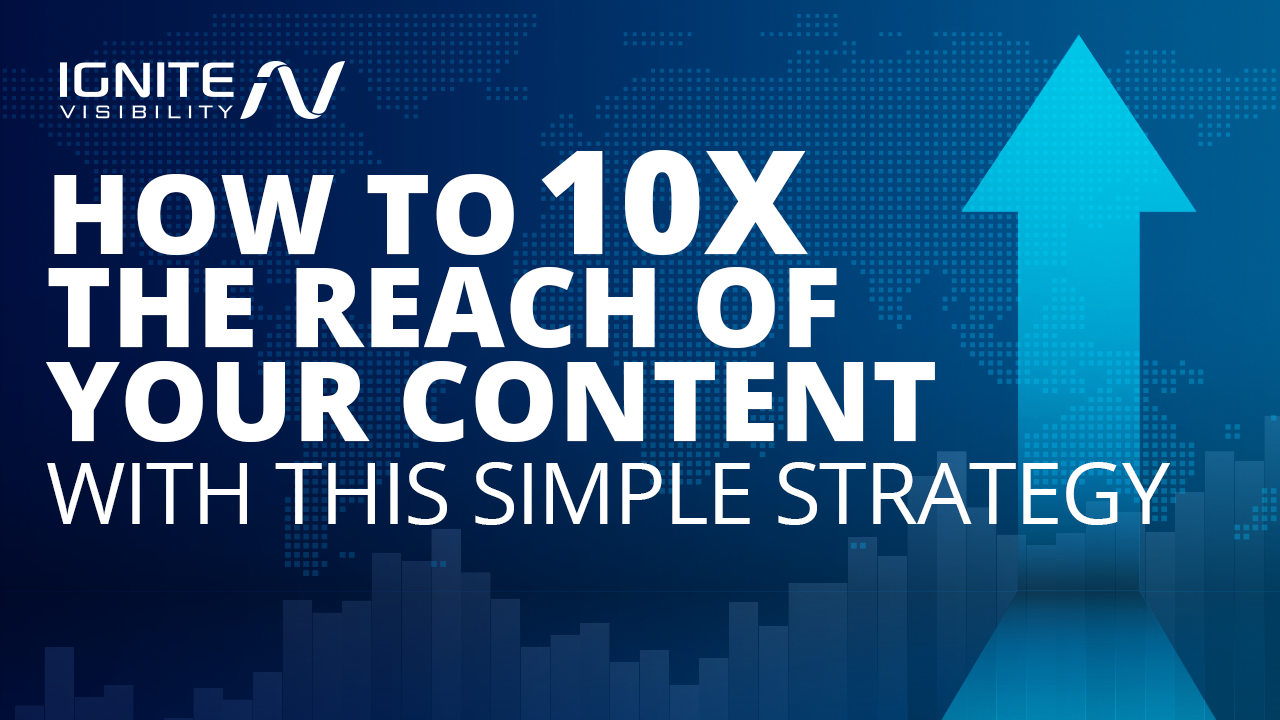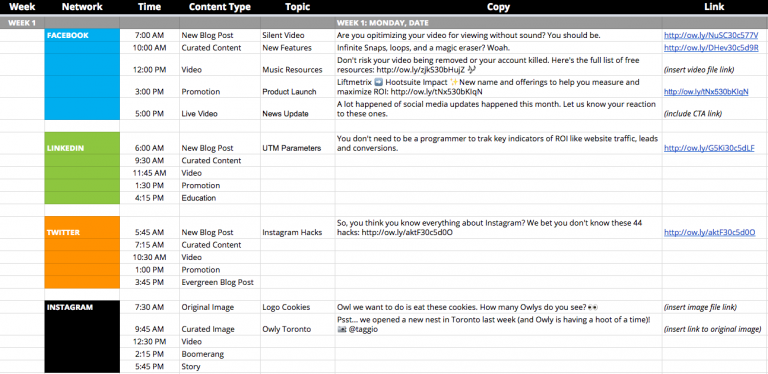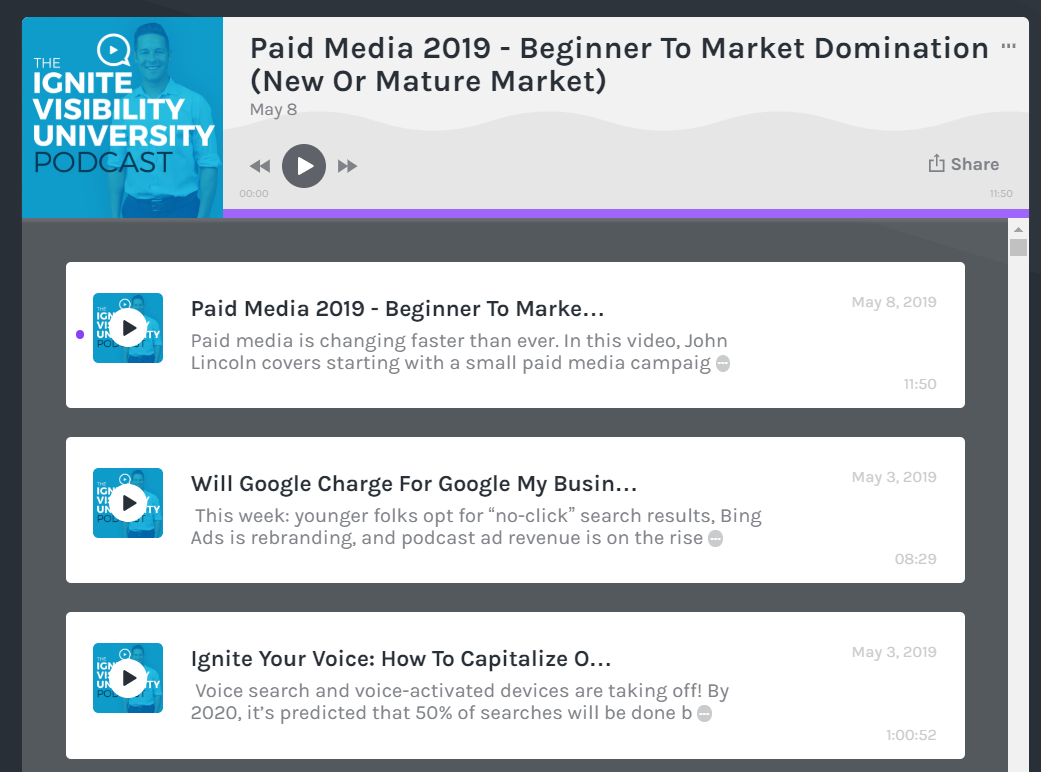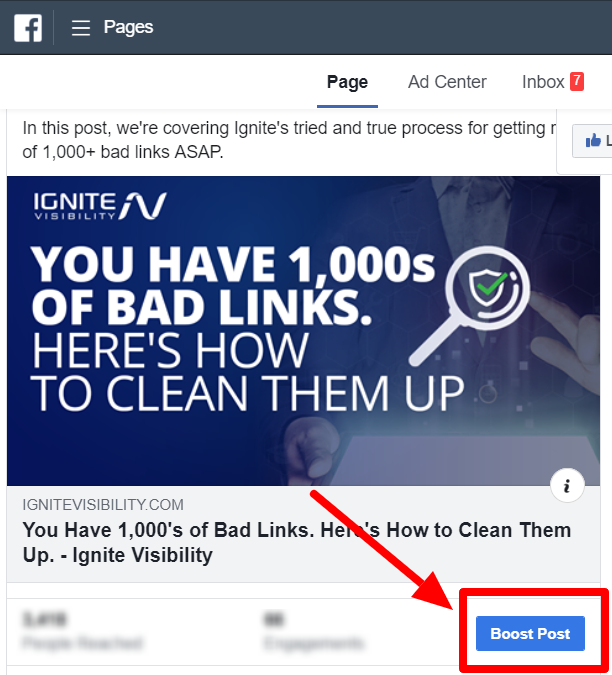Content’s reign as king isn’t ending anytime soon.
Simply put, a content strategy that prioritizes consistent, high-quality content is one of the surest ways to stay relevant to your audience and increase your rankings. But simply creating that content and hoping your audience finds it isn’t enough.
In this article, I’ll teach you a simple content strategy that will help you gain 10x the reach.

What You’ll Learn:
- How to: set a multi-channel strategy
- How to: start with killer blog topics
- How to: incorporate video
- How to: branch into podcasts
- How to: add in paid media
Lesson number 1: your work isn’t done once you’ve written an article.
One of the things I’m really big on is creating one piece of content and pushing it out everywhere. If you want to be a thought leader, you need to build your reputation and increase your reach.
While some people believe that a well-written article will flourish on its own, today’s fragmented marketing landscape means that diversifying your content mix is mandatory.
Limiting yourself to one format or one platform means you’ll miss out on opportunities to connect with new audiences. Making yourself accessible through multimedia syndication allows you to connect with new audiences, without the need to work yourself to death by creating multiple pieces of content.
The content strategy here is simple: create one killer piece of content, repurpose it, and syndicate all over the place from video to social to podcasts and beyond.
Getting Started: Multi-Channel Strategy
Thought leadership is less about driving sales than it is about providing a distinct point of view about your industry and the trends, challenges, and best practices in your space.
In other words, it’s about leadership.
You want someone to come across your content and think, “hey, I think I might try that” or “wow, I never thought to approach X like Y.”
As you start considering the topics you want to cover and how to present those topics, you’ll need to figure out how to make your message both unique and compelling.
Which, if we’re honest, is the hardest part of the process. The best way to ensure there’s enough interesting content to fill multiple feeds is to get organized.
Establish a Content Calendar
To nail this thought leadership push, you’ll need to have a solid content strategy in place. Map out a content calendar that includes topics, a publishing schedule, and who is responsible for creating these items.
Initially, you’ll need to come up with a plan for the types of content you plan on publishing online, how often you can realistically create new content, and where you plan on promoting it.
For example, you might start with a list of categories you’d like to cover. Break them down into topics and how you’d like to approach each topic by channel.
I recommend adding each item–the initial blog post, plus video, podcasts, and their associated paid campaigns to a calendar, so things stay on schedule.
If you don’t want to create your own calendar from scratch, or simply want a guide to model yours after, CoSchedule and Hubspot both offer free templates you can download and adapt.

A good content strategy starts with a calendar. Example courtesy of Hootsuite
Get to Work on that Distribution Strategy
The distribution aspect of your content strategy isn’t something that should be treated as an afterthought. You probably should spend at least as much time thinking about promoting your content as you do writing and recording it.
First, you’ll need to figure out where your audience hangs out online. If your core demographic works in B2B or a traditional industry like finance or sales, LinkedIn might be their platform of choice. Retail companies might stick to Instagram and Facebook, whereas marketing and media pros tend to gravitate toward Twitter.
Distributing your content on social media is a tried and true way to get in front of your audience and build relationships with them.
But to get that 10X reach, you’ll need to embrace a mix of paid ads and organic posts and really pound the pavement when it comes to posting everywhere and often.
1. Start With a Blog Post
More often than not, I start my entire multi-channel content strategy with a good blog idea. So, I might come up with something like “How to Grow a Paid Media Audience.”
I’d take that idea, turn it into a blog post, and put together a YouTube video that covers key points in a couple of minutes. From there, I can post those two pieces as one blog post—a video embedded within a longer article.
Other formats you can do use to repurpose your blog posts include:
- Turn Content into an Infographic
- Create a SlideShare
- Break Text Into Shorter Snippets
I recommend promoting blog content on Twitter, LinkedIn, and Facebook first, as these channels don’t focus solely on video content like YouTube or Instagram.
Once you have that post, you should also work on syndicating it out to various other publications. Guest posting, as you know, is one of the best ways to increase the number of eyes on your content. But that doesn’t mean you have to create a completely new piece every time you guest post.
Instead, take that same long-form piece you created for your site and repurpose it into a smaller, 800-word article. For more on my specific syndication strategies, check out my full article on content syndication here.
2. Incorporate Video in Your Content Strategy
According to Aberdeen research, marketers who use video in their marketing strategy see almost 50% more growth in revenue as compared to marketers who skip out on video content.
So, one idea is to use video as part of your content strategy to generate more website traffic. Your video allows you to use your expertise to let your audience know that you understand their problems and know how to solve them.
Like any blog posts or articles you create, these should provide value to your audience. Use your expertise to solve the common problems of your viewers. Don’t forget to be creative while creating these videos.
Let’s say you’ve created a blog post covering different Facebook ads strategies. Now, the blog might cover a range of tactics and how to deploy those tactics on your website.
You can create a video outline based on the key themes in that long-form post, summing up the points you made throughout the article. From there, if someone wants to learn more, they can scroll down and read the full post.
Or, if the visitor finds that video through a boosted Facebook post, you might include a call-to-action promoting the blog.
Once you create a video, that video goes everywhere:
- YouTube–The perfect place for how-to videos, short clips, explainers, and more, YouTube boasts a massive audience collectively watching a billion hours of video every day.
- Facebook Video–Facebook video is ideal for capturing viewer attention straight from the feed. Because videos play automatically, you’ll want to add captions (back to the blog post) and focus on eye-catching imagery to draw people in.
- IGTV–Best used to promote longer videos or give viewers a behind-the-scenes look at your brand. The benefit of IGTV videos is that they take up the entire screen and start playing right when they open the app.
- Instagram Stories–Posting your video to Instagram Stories might be an effective way to attract new traffic to a blog post on the same topic. After all, Instagram now allows businesses to include links in their Stories, so followers can swipe up to read the full post. And, as we’ve discussed, Stories provide both a creative way to engage your audience and place your content at the top of the feed.
3. Create Podcasts
Though podcasting has been around since 2004, it’s only really exploded over the past few years.
Creating a podcasting program from scratch is no small feat, but it’s an impactful way to increase brand awareness, share information, and even drive website traffic or access new revenue streams.
That said, the biggest challenge of podcasting isn’t the recording process or even the distribution. It’s creating a consistently high-quality stream of content.
Did you know that you can record a video and turn it into a podcast? That initial blog post can be turned into a video, and then into an audio file. Who knew that one piece of content could be so versatile?
I like to use a YouTube Video to Audio Converter so I can upload an audio file to Anchor FM.
Search for “YouTube Video to Audio,” and there are a whole host of web apps dedicated to turning video content into an MP3 file, which you can then download and share on the platform.
For those new to podcasting, Anchor is a free app that allows you to create a podcast, record clips, and publish your audio on all major podcasting platforms in just one click. What’s nice about this platform is you don’t need to manage your RSS feed manually or submit your work to every single channel.
Once you’ve created an episode, you can use Anchor to distribute your podcast on iTunes, Google Play, Stitcher, Spotify, Overcast, and others.

If your content strategy includes podcasts, try uploading them to Anchor.fm
We should mention that every episode does need to be approved on each platform. So, if you have specific launch dates planned, you may want to front-load a few episodes at a time to avoid delays.
Typically, it takes a few business days for your podcast to get the initial approval, and subsequent uploads can take up to a week to go live. For the record, Stitcher’s approval times are slightly faster than Apple and Google, but there’s no definitive timeline.
To avoid rejections, you’ll need to have the following pieces of information ready to go:
- Podcast name and description
- At least one episode
- Episode descriptions and titles
- Cover art — 1400 x 1400 pixels
- Audio file — MP3 or Mp4
From there, you can promote your podcast episodes on your website and social media accounts to attract more listeners.
Which brings us to our next point.
Make Sure You’re Running Ads on Social Media as Part of Your Content Strategy
Creating great and varied content is a great way to demonstrate your value and expertise on a small scale. Sometimes, you have to pay to play on that larger scale.
Your content might be too niche to reach its target audience without a little boost. Or maybe you want to crossover into a new audience base.
For the most part, your ad strategies will differ more by campaign goals and messaging rather than whether something is a video or a blog.
That said, there are a few key differences you’ll need to consider by medium.
Blogs
To attract more readers to your blog posts, run paid ads on Twitter, Facebook, and LinkedIn. These platforms are your best choices for promoting written content.
Remember that Facebook is the largest social media platform and that it caters to both B2B and B2C audiences.

Social promotion should be part of your content strategy
As such, you’ll need to be strategic about the language you use to talk to your various groups. As we’ve discussed in the past, you can filter Facebook users by behavior, interests, demographics, and their friends.
If you want to take a deep dive into Facebook Ads, this post breaks it all down for you.
Twitter’s ad platform is another great way to boost traffic to your site. You can link your posts to different campaigns aimed at capturing leads, growing an audience, and specifically targeting the people most likely to read your content and take action.
Videos
With video, one of the best ways to attract new traffic is through YouTube SEO. I go over some of the basics in this post, including things like selecting keywords and maintaining a consistent quality as you start to build out your library and fit into your content strategy.
Another option is LinkedIn video. This business-centric platform works best for sharing videos that look at industry trends, tips and tricks, and re-capping highlights from in-depth blog posts (read: driving traffic to your website). While LinkedIn content should err on the side of being professional, don’t be afraid to get candid.
Paid video can be linked to three types of campaigns: awareness, consideration, and demand generation–so make sure your content reflects whichever goal you select.
Podcasts
As is the case with blog posts and videos, simply adding your episodes to the right platforms doesn’t guarantee success. Look toward Facebook, Instagram, LinkedIn, and Twitter to expand your reach and boost visibility.
While audio may pose some challenges when it comes to visuals, you can create graphic pull quotes from the episode, include a short video teaser, or add an infographic that touches on the main themes in the episode.
With podcasting, you’ll likely win more friends by running your paid ads as awareness campaigns, rather than trying to sell on the spot. That said, you could tie podcast content to a Facebook Lead Generation campaign or promote an in-depth webinar on the same subject matter.
Wrapping Up
This 10X reach content strategy is a simple concept, but the execution demands some careful planning.
It’s content planning, scheduling, and creating. Then, it’s all about distribution. You’ll also need to consider all channels from paid and earned media to guest posting and YouTube videos, Instagram Stories, and LinkedIn.
As you experiment with these different strategies, take note of which formats, platforms, and topics get the most play with your audience and how these metrics vary across channels.
From there, you can optimize your distribution strategy so that podcasts, videos, and blog posts connect with the right people at the right time.
And one last thing; be patient. Growing your audience is all about playing the long game.